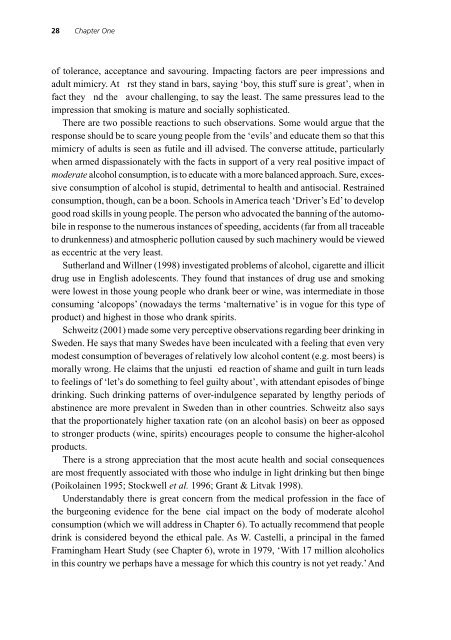Beer : Health and Nutrition
Beer : Health and Nutrition
Beer : Health and Nutrition
Create successful ePaper yourself
Turn your PDF publications into a flip-book with our unique Google optimized e-Paper software.
28 Chapter One<br />
of tolerance, acceptance <strong>and</strong> savouring. Impacting factors are peer impressions <strong>and</strong><br />
adult mimicry. At rst they st<strong>and</strong> in bars, saying ‘boy, this stuff sure is great’, when in<br />
fact they nd the avour challenging, to say the least. The same pressures lead to the<br />
impression that smoking is mature <strong>and</strong> socially sophisticated.<br />
There are two possible reactions to such observations. Some would argue that the<br />
response should be to scare young people from the ‘evils’ <strong>and</strong> educate them so that this<br />
mimicry of adults is seen as futile <strong>and</strong> ill advised. The converse attitude, particularly<br />
when armed dispassionately with the facts in support of a very real positive impact of<br />
moderate alcohol consumption, is to educate with a more balanced approach. Sure, excessive<br />
consumption of alcohol is stupid, detrimental to health <strong>and</strong> antisocial. Restrained<br />
consumption, though, can be a boon. Schools in America teach ‘Driver’s Ed’ to develop<br />
good road skills in young people. The person who advocated the banning of the automobile<br />
in response to the numerous instances of speeding, accidents (far from all traceable<br />
to drunkenness) <strong>and</strong> atmospheric pollution caused by such machinery would be viewed<br />
as eccentric at the very least.<br />
Sutherl<strong>and</strong> <strong>and</strong> Willner (1998) investigated problems of alcohol, cigarette <strong>and</strong> illicit<br />
drug use in English adolescents. They found that instances of drug use <strong>and</strong> smoking<br />
were lowest in those young people who drank beer or wine, was intermediate in those<br />
consuming ‘alcopops’ (nowadays the terms ‘malternative’ is in vogue for this type of<br />
product) <strong>and</strong> highest in those who drank spirits.<br />
Schweitz (2001) made some very perceptive observations regarding beer drinking in<br />
Sweden. He says that many Swedes have been inculcated with a feeling that even very<br />
modest consumption of beverages of relatively low alcohol content (e.g. most beers) is<br />
morally wrong. He claims that the unjusti ed reaction of shame <strong>and</strong> guilt in turn leads<br />
to feelings of ‘let’s do something to feel guilty about’, with attendant episodes of binge<br />
drinking. Such drinking patterns of over-indulgence separated by lengthy periods of<br />
abstinence are more prevalent in Sweden than in other countries. Schweitz also says<br />
that the proportionately higher taxation rate (on an alcohol basis) on beer as opposed<br />
to stronger products (wine, spirits) encourages people to consume the higher-alcohol<br />
products.<br />
There is a strong appreciation that the most acute health <strong>and</strong> social consequences<br />
are most frequently associated with those who indulge in light drinking but then binge<br />
(Poikolainen 1995; Stockwell et al. 1996; Grant & Litvak 1998).<br />
Underst<strong>and</strong>ably there is great concern from the medical profession in the face of<br />
the burgeoning evidence for the bene cial impact on the body of moderate alcohol<br />
consumption (which we will address in Chapter 6). To actually recommend that people<br />
drink is considered beyond the ethical pale. As W. Castelli, a principal in the famed<br />
Framingham Heart Study (see Chapter 6), wrote in 1979, ‘With 17 million alcoholics<br />
in this country we perhaps have a message for which this country is not yet ready.’ And

















